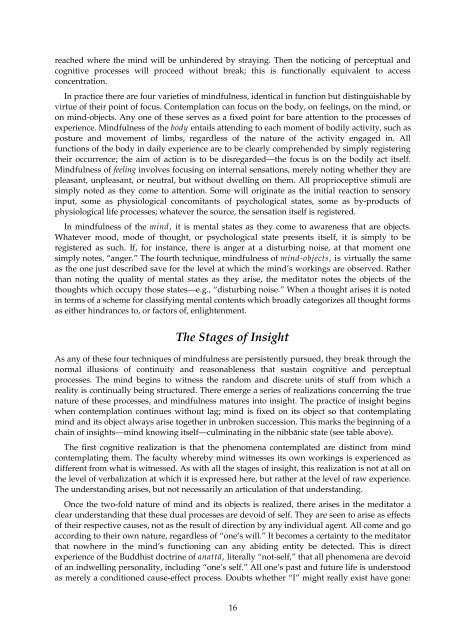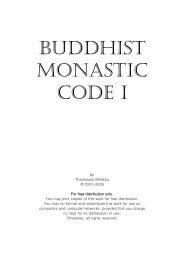THE BUDDHA W MEDITATION - Theravada Buddhism
THE BUDDHA W MEDITATION - Theravada Buddhism
THE BUDDHA W MEDITATION - Theravada Buddhism
You also want an ePaper? Increase the reach of your titles
YUMPU automatically turns print PDFs into web optimized ePapers that Google loves.
eached where the mind will be unhindered by straying. Then the noticing of perceptual and<br />
cognitive processes will proceed without break; this is functionally equivalent to access<br />
concentration.<br />
In practice there are four varieties of mindfulness, identical in function but distinguishable by<br />
virtue of their point of focus. Contemplation can focus on the body, on feelings, on the mind, or<br />
on mind-objects. Any one of these serves as a fixed point for bare attention to the processes of<br />
experience. Mindfulness of the body entails attending to each moment of bodily activity, such as<br />
posture and movement of limbs, regardless of the nature of the activity engaged in. All<br />
functions of the body in daily experience are to be clearly comprehended by simply registering<br />
their occurrence; the aim of action is to be disregarded—the focus is on the bodily act itself.<br />
Mindfulness of feeling involves focusing on internal sensations, merely noting whether they are<br />
pleasant, unpleasant, or neutral, but without dwelling on them. All proprioceptive stimuli are<br />
simply noted as they come to attention. Some will originate as the initial reaction to sensory<br />
input, some as physiological concomitants of psychological states, some as by-products of<br />
physiological life processes; whatever the source, the sensation itself is registered.<br />
In mindfulness of the mind, it is mental states as they come to awareness that are objects.<br />
Whatever mood, mode of thought, or psychological state presents itself, it is simply to be<br />
registered as such. If, for instance, there is anger at a disturbing noise, at that moment one<br />
simply notes, “anger.” The fourth technique, mindfulness of mind-objects, is virtually the same<br />
as the one just described save for the level at which the mind’s workings are observed. Rather<br />
than noting the quality of mental states as they arise, the meditator notes the objects of the<br />
thoughts which occupy those states—e.g., “disturbing noise.” When a thought arises it is noted<br />
in terms of a scheme for classifying mental contents which broadly categorizes all thought forms<br />
as either hindrances to, or factors of, enlightenment.<br />
The Stages of Insight<br />
As any of these four techniques of mindfulness are persistently pursued, they break through the<br />
normal illusions of continuity and reasonableness that sustain cognitive and perceptual<br />
processes. The mind begins to witness the random and discrete units of stuff from which a<br />
reality is continually being structured. There emerge a series of realizations concerning the true<br />
nature of these processes, and mindfulness matures into insight. The practice of insight begins<br />
when contemplation continues without lag; mind is fixed on its object so that contemplating<br />
mind and its object always arise together in unbroken succession. This marks the beginning of a<br />
chain of insights—mind knowing itself—culminating in the nibbānic state (see table above).<br />
The first cognitive realization is that the phenomena contemplated are distinct from mind<br />
contemplating them. The faculty whereby mind witnesses its own workings is experienced as<br />
different from what is witnessed. As with all the stages of insight, this realization is not at all on<br />
the level of verbalization at which it is expressed here, but rather at the level of raw experience.<br />
The understanding arises, but not necessarily an articulation of that understanding.<br />
Once the two-fold nature of mind and its objects is realized, there arises in the meditator a<br />
clear understanding that these dual processes are devoid of self. They are seen to arise as effects<br />
of their respective causes, not as the result of direction by any individual agent. All come and go<br />
according to their own nature, regardless of “one’s will.” It becomes a certainty to the meditator<br />
that nowhere in the mind’s functioning can any abiding entity be detected. This is direct<br />
experience of the Buddhist doctrine of anattā, literally “not-self,” that all phenomena are devoid<br />
of an indwelling personality, including “one’s self.” All one’s past and future life is understood<br />
as merely a conditioned cause-effect process. Doubts whether “I” might really exist have gone:<br />
16






